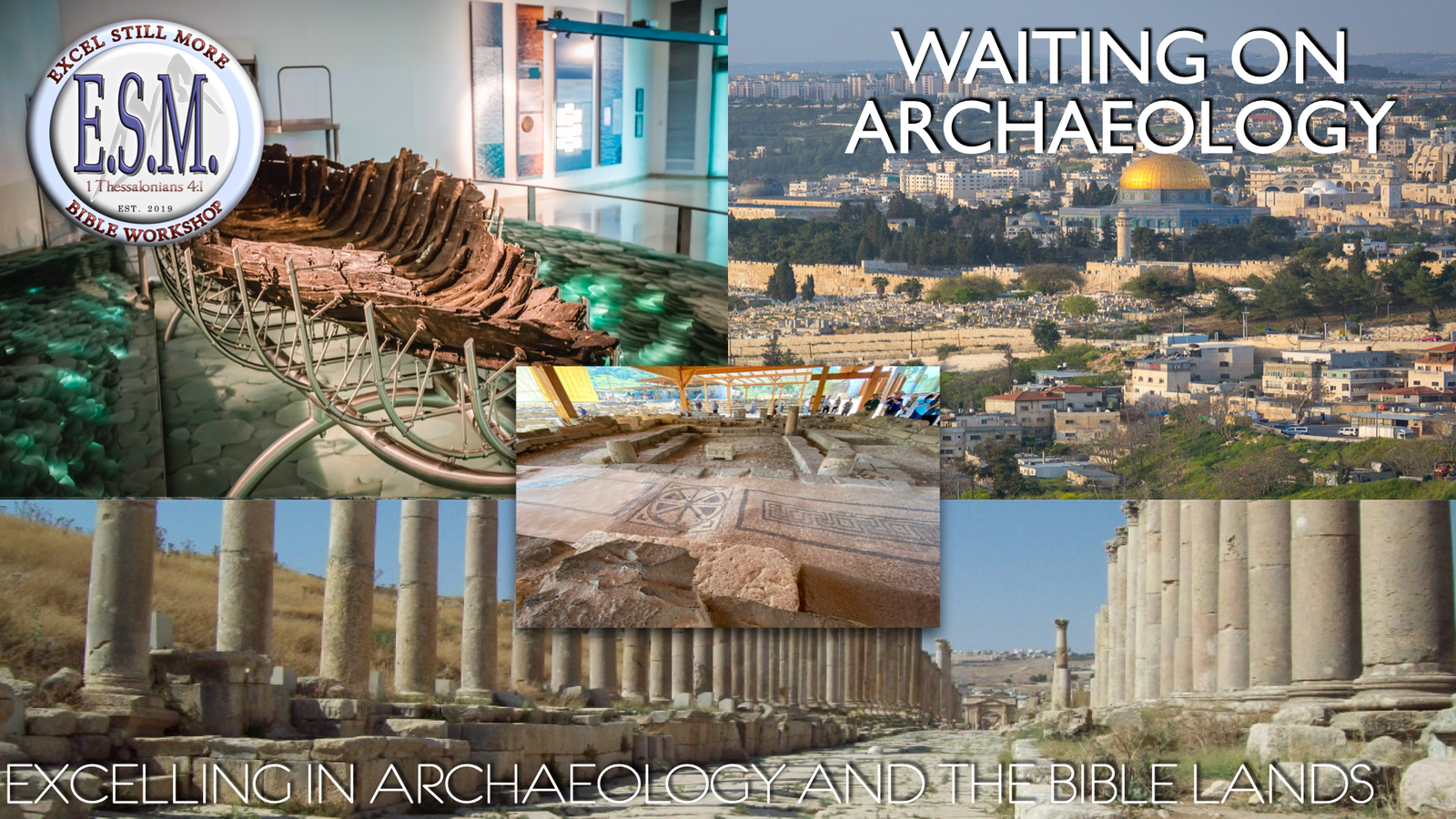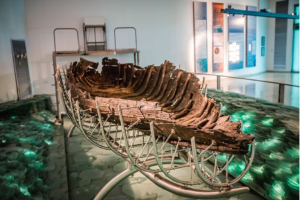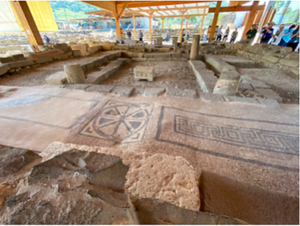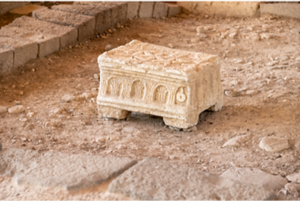The Sea of Galilee was on the retreat. The 1985-86 drought in Israel had the nation deeply concerned about the future of the country’s most essential commodity. With the declining availability of water, the lives of numerous citizens would be greatly affected. The economy was sure to suffer. Water rationing would occur, and those dependent upon the water to grow their crops would feel the terrible impact. But as with so many hardships, something good usually results from something tragic. This time, “the good” materialized when the waters receded along the drought-stricken shore in Galilee. It was a long-lost treasure that would change the lives and the economy of the small towns and villages around Israel’s most famous body of water.
As local fishermen Moshe and Yuval Lofan walked along the newly exposed shoreline between the modern towns of Ginosar and Migdal, they happened upon the tip of an unusual structure inconspicuously protruding from the water’s edge. Excitedly, they began digging and discovered what would later be a 2000-year-old fishing vessel deeply entombed within the mud of the Sea of Galilee. Through a painstaking ten-day process of excavation, followed by years of careful preservation, this beautifully preserved relic from the time of Jesus came to be anchored on permanent display in the Yigal Alon Museum at Nof Ginosar. The boat’s design and composition, along with an accompanying cooking pot, arrowhead, nails, hooks, and oil lamp, have led archaeologists to confidently date the boat’s use to the time of Christ.
In perhaps one of the greatest marketing schemes to attract tourists, this 27-foot-long and 7.5-foot-wide ancient fishing vessel was cleverly dubbed the “Jesus Boat.” Studies have shown that 15 average-sized men of the era could have fit in this type of boat. So, did Jesus and his disciples use this boat? No one can know for sure, but the lure of getting so close to something in use during the time of Jesus is nevertheless exciting. Millions have passed by this celebrated exhibit on their way to another of Israel’s most exciting adventures: sailing in a modern boat across the sea where Jesus performed many of his miracles. Yet, seeing the “Jesus Boat” and sailing the waters that our Lord quieted is only a small part of the full historical experience. In recent years, many other important discoveries have been made.
Only a short distance from where the Lofan brothers discovered the 2000-year-old boat lay one of the most exciting and important discoveries of the 21st century. For decades now, archaeologists have been digging in and around the coastal area just below Mount Arbel and south of modern day Migdal. Until 1948, the dig site had been the location of
an Arab village known as al-Majdal, meaning “tower.” The Hebrew word Migdal likewise means “tower,” and it is almost certain, based on ancient historians, that this location is the biblical Magdala mentioned in Matthew 15:39 and the hometown of Mary Magdalene. But, beyond its name, the area is rich with archaeological discoveries containing several boat docks, houses, commercial buildings, and a mosaic floor depicting an ancient fishing vessel. To the south and west, examples of both modest and upper-class homes were discovered along with several Jewish mikvehs (ritual cleansing baptistries). Artifacts of all types surfaced within the remains of this once-thriving community of first-century Jews, but one of the ruin’s most important treasures did not fully come to light until a few short years ago.
However, the context of this important discovery should be considered first in light of biblical criticism and what Matthew said about the public ministry of Jesus. The Bible records that…
“Jesus was going throughout all Galilee, teaching in their synagogues and proclaiming the gospel of the kingdom, and healing every kind of disease and every kind of sickness among the people” …Matthew 4:23
Mark reveals that Jesus physically “entered” a synagogue and performed a miracle (Mark 3:1-4). The Gospel writers speak of several key miracles and teachings that occurred at the synagogue, with the word synagogue appearing more than 50 times in the New Testament. So, the synagogue stood as a central part of the biblical descriptions surrounding the ministry of Jesus. But did they exist?
Some argue that the Bible can’t always be trusted on history matters, especially without evidence. Some won’t believe a particular claim unless archaeologists can verify it.
For example, it was only a few years ago that a few New Testament scholars had been insistent that synagogue buildings did not exist during or before the New Testament era and that the Bible’s use of the word synagōgē (synagogue) was either a mistake or an anachronism.
Howard Clark Kee, Professor of Biblical Studies at the Boston University School of Theology, once proffered that a synagogue building never existed in Palestine until the 3rd Century A.D. He also suggested that when Bible writers referred to one, they must have referred to a mere assembly or gathering of people (Kee 1-24). Others, like Robert Price in his book The Incredible Shrinking Son of Man, likewise assert that “a major collision between the gospel tradition and archaeology” exists regarding the presence of synagogues prior to A.D. 70 (Price 14).
Though several literary sources (e.g., Josephus, Philo, and the Bible) and a first-century dedicatory inscription (i.e., Theodotus Inscription) had testified to the existence of first-century synagogues, most extant synagogue ruins were from the Byzantine period (4th to 7th Century A.D.), and thus offered little help in answering the critics. However, conclusions have now changed in a major way.
In 2009, the Legionaries of Christ, a Catholic order founded in Mexico, planned to construct a new retreat center adjacent to the archaeological excavations at Migdal. Shortly after preliminary work began, an amazing discovery was unearthed. Archaeologists from the Israeli Antiquities Authority were performing their required pre-construction site inspection when they discovered the top of an ancient wall buried in a remote corner of the property. The excitement only grew as workers gradually uncovered what looked to be a rough-cut stone bench. Further digging exposed even more benches along the walls of this 36’ X 36’ shaped structure, and it soon became apparent that they were standing in the midst of an ancient Jewish house of worship—an ancient synagogue of the Jews.
Though big enough for only 200 people, the Magdala Synagogue contained several skillfully carved stone columns, elaborately decorated mosaic floors with common first-century geometric designs, and frescoes with yellow, red, and blue paint, which were found on the walls and column remains. A foyer area was discovered along with rooms, presumably to store the sacred scrolls of scripture. Outside the synagogue, a bowl was found, which may have been used in the ritual washing of hands as one entered the building. The Magdala synagogue has yielded numerous artifacts, but perhaps the most unique item was found at the center of this 2000-year-old structure.
As archaeologists continued to peel back the layers of dirt and debris from this buried building, a large, unusual-looking object began to appear. The object was a Torah reading table made of stone. It measured 1.8 by 2 feet with a height of 1 foot and was found in situ (in its original placement) in the middle of the synagogue structure. On the top and back panels, one can easily decipher floral rosette carvings along with palm trees similar to what was carved in the sanctuary of Solomon’s temple (1 Kings 6:29-35). On its front side, there are a number of carved symbols: a seven-branch candelabrum (menorah) standing above a square pedestal, flanked on both sides by two-handled jugs. The three objects are positioned under an arch held by two side pillars with bases and capitals. The two long sides of the table are identical, showing four arches. The three left arches are filled with sheaves of grain, while the rightmost arch is filled with an object that looks like an oil lamp (Rotem). All of these carvings, iconographic of both the first and second temples that existed in Jerusalem, certainly convey many themes, but their presence at the Magdala synagogue loudly declares the value and importance that first-century Jews placed upon this religious gathering place.
The Magdala Synagogue had all the markings and evidence (e.g., diagnostic shards and coins) of a building in use during the time of Jesus (Garza-DiazB). A coin minted in Tiberias in 29 CE was found inside the synagogue. The presence of this coin, as well as the unique features and architectural design of the building, proved that the synagogue was in existence during the time of Christ.
Matthew’s account tells us that Jesus…
“went about all Galilee, teaching in their synagogues, and preaching the gospel of the Kingdom” …Matthew 4:23
Therefore, it is nearly certain that Jesus stood and taught at this place. This fact alone has drawn many who are on a personal quest to Magdala in order actually to walk where Jesus walked.
The synagogue at Magdala is currently the oldest excavated in Galilee and one of the most celebrated—but it’s not the only one of its kind. In the 2011 July/August edition of Biblical Archaeology Review, Glenn J. Corbett, Associate Director of the American Center of Oriental Research (ACOR) in Amman, Jordan, claimed that seven first-century synagogues have now been discovered (Corbett 52). His list includes Masada, Herodium, Gamla, Herodian Jericho, Qiryat Sefer, Modi’in, and Magdala (some would add Kfar Ethra). Admittedly (but not surprisingly), this list is disputed, even by some Israeli Jewish guides I have worked with. However, in the summer of 2019, my wife and I visited seven first-century synagogues, and while I am certainly not a professional archaeologist, I can report to you that those who have unequivocally affirmed that five are most definitely from the first century.
So, did synagogue buildings actually exist as the New Testament records? Did Jesus preach in an actual synagogue, and have they been discovered? Without a doubt, they did, and they have. It’s been proven time and time again that the Bible story takes place within a real, verifiable, historical context. With the discoveries mentioned above, along with the numerous Bible references to the Lord’s ministry surrounding a fishing community, specific names of towns and people, the use of the Torah, and the references to synagogues, we are again reminded of the accuracy of scripture and its credibility as historically accurate in every detail. As the evidence continues to mount, the Bible believer once more finds him or herself growing in appreciation and confidence in the testimony of the biblical record. These discoveries also remind us of an age-old fallacy committed by the critic: using the absence of evidence to attempt to prove that something doesn’t exist. As with so many other previous indictments of alleged errors in scripture, we may need to wait on archaeology to catch up with the truth of the Bible. Even still, with all of the current discoveries in archaeology, it is certainly a tough time to be a critic.
Resources and Works Cited
Byers, Gary (Associates for Biblical Research). “Did Jesus really sit on this ancient boat from the Sea of Galilee?” https://christiananswers.net/q-abr/abr-a003.html
Corbett, Glenn J. “New Synagogue Excavations In Israel and Beyond,” Biblical Archaeology Review 37.4. 2011. 52–59.
DeVries, LaMoine F. Cities of the Biblical World: An Introduction to the Archaeology, Geography, and History of Biblical Sites. Peaboy, MA., Hendrickson, 1997.
Dospel, Mark. “Discoveries in Mary Magdalene’s Hometown: Four ritual baths unearthed in the Magdala Excavations.” 2017, Bible History Daily: Biblical Archaeology Society. www.biblicalarchaeology.org/daily/biblical-sites-places/biblical-archaeology-sites/discoveries-in-mary-magdalenes-hometown. Accessed 25, May 2018.
Garza-DíazB, Andrea. “The Archaeological Excavations at Magdala.” Ancient History Encyclopedia. Ancient History Encyclopedia, 19 Apr 2018. Web. 25 May 2018.
Hadashot Arkheologiyot: Excavations and Surveys in Israel: http://www.hadashot-esi.org.il/search_eng.aspx (Israel Antiquities Authority).
IES, http://israelexplorationsociety.huji.ac.il/arad.htm.
Josephus. Jewish Wars.
Kee, H.C. “The Transformation of the Synagogue After 70 C.E.; Its Import for Early Christianity” New Testament Studies 36:1, 1990: 1-24.
Laughlin, John C. “Caparnaum: From Jesus Time and After.” Biblical Archaeology Review September/October, 1993, 55-61
Ma‘oz, Zvi Uri, Vassilios Tzaferis, and Moshe Hartal. “Banias.” The New Encyclopedia of Archaeological Excavations in the Holy Land. Ed. Ephraim Stern. Jerusalem: Israel Exploration Society; Washington, DC: Biblical Archaeology Society, 2008. 1587–1594.
McCarter, P. Kyle. Ancient Inscriptions: Voices from the Biblical World. Washington, D.C., Biblical Archaeology Review, 1996.
Price, Robert M. The Incredible Shrinking Son of Man: How Reliable is the Gospel Tradition? Amherst, New York, Prometheus Books, 2003.
Rotem, Israel; https://www.biblewalks.com/magdala.
Zapata-Meza, Marcela, and Rosaura Sanz-Rincón. “Excavating Mary Magdalene’s Hometown,” Biblical Archaeology Review, May/June, 43.3. 2017, 37–42.
ENDNOTES
1 “Did Jesus really sit on this ancient boat from the Sea of Galilee?” Gary Byers, Associates for Biblical Research; https://christiananswers.net/q-abr/abr-a003.html
2 Director of the Magdala Archaeological Project, Marcela Zapata-Meza, believes these ruins to be the place of the town referenced in scripture and the place referred to among the Romans as Taricheae. Assistant Editor at BAR, Marek Dospěl also attests to al-Majdal being the site of the biblical Magdala, saying, “modern archaeological excavations at Taricheae/al-Majdal/Magdala on the shore of the Sea of Galilee confirm the testimonies of ancient authors about the affluence and prosperity of this Galilean city and give more credence to the identification of Taricheae with Magdala” (Dospěl). The ancient historian Josephus correctly locates Magdala 30 stadia (c. 3.5 mi) north of Tiberias. The city is also mentioned by other Classical authors, such as Cicero, Suetonius and Strabo, the latter commenting on its excellent fish, highly esteemed in Roman markets (Zapata-Meza 38). In our modern era a town by the name of Migdal exists at the edge of the plains of Gennesaret, just north of where the archaeological ruins, ancient boat docks, and synagogue were discovered. In Jesus’ time the city was known under its Greek name Taricheae from the Greek tarichos, which means “salted, smoked or dried meat, especially fish.” This name is befitting of the city given the ancient boat docks and market discovered in the area. It was also mentioned in the writings of the Roman polymath Pliny the Elder, who inaccurately locates it south of Tiberias.
3 Many believe the reference to Mary Magdalene (Luke 8:2, etc.) is to be taken as “Mary who is from Magdala” to distinguish her from the many other “Marys” identified in scripture; a common name in use during Bible times.
4 The following description given on the City of David website: “This inscription, written in Greek, was discovered in an excavation conducted by Raymond Weill in the southern part of the City of David from 1913-1914 and is currently on display in the Israel Museum. The inscription mentions a priest by the name of Theodotus (which means “god gave” in Greek) who established a synagogue that is dated to the last hundreds of years of the Second Temple period. A number of synagogues have been found throughout Israel from this time period. The inscription gives us a peek into the nature of a Second Temple synagogue during a period when the synagogue was used as a place to read the Bible and learn about God’s commandments, and not for prayer as it is today. Additionally, the inscription refers to the presence of a facility with water which is either a bath house or a mikvah (ritual bath), as well as guest rooms probably used by Jewish pilgrims who made their way to Jerusalem and required a place to wash and rest during their journey.”https://www.cityofdavid.org.il/en/archeology/finds/theodotus-inscription
5 See “The Magdala Stone: The Jerusalem Temple Embodied” by Jennifer Ristine.https://www.biblicalarchaeology.org/daily/ancient-cultures/ancient-israel/the-magdala-stone/









